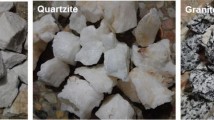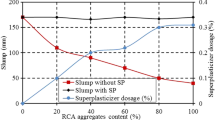Abstract
This paper presents the results of an investigation into the effects of increasing shale content in nominally “quartzite” aggregates on the creep and shrinkage behaviour of concretes made with such aggregate. The investigation was prompted by concern because of the increasing presence of the weaker and poorly shaped shale particles appearing in the quartzite aggregates being used in the Gauteng region of South Africa. In this investigation, two strength grades of concrete were prepared using varying proportions of shale in the stone and sand fractions of the quartzite aggregates. A secondary outcome of this investigation was the opportunity to assess the effect of aggregate type on the prediction of concrete creep and shrinkage using Model B3.
The results indicate that increasing shale content in concrete has a significant effect in increasing both creep and shrinkage strains. Shrinkage increases almost linearly with increasing shale content of the total aggregate. On the other hand, shale in the sand fraction appears to have a larger effect in increasing creep than shale in the stone fraction. An assessment of the need for an aggregate-based adjustment to Model B3 is also presented.
Résumé
Cet article présente les résultats d’une recherche relative aux effects que peut avoir l’augmentation de la teneur en schiste dans des granulats nominalement “quartzites” sur le comportement des bétons faits avec de tels granulats. La présente recherche est née du souci de comprendre la teneur croissante des particules de schiste plus faibles et mal formées apparaissant dans les granulats quartzites utilisés dans la région de Gauteng en Afrique du sud. Au cours de cette recherche, deux gammes de résistance de béton ont été préparées en utilisant des proportions variables de schiste dans les fractions de pierre et de sable des granulats quartzites. La recherche a aussi été l’occasion d’évaluer les effets du type granulat sur la prévision du fluage et du retrait du béton en utilisant le modèle B3. Les résultats indiquent qu’une augmentation de la teneur de schiste dans du béton a un effet significatif sur l’augmentation des contraintes du fluage et du retrait. Le retrait augmente presque linéairement avec l’augmentation de la teneur en schiste du granulat total. D’autre part, le schiste dans la fraction de sable semble avoir un plus grand effet sur l’augmentation du fluage que le schiste dans la fraction en pierre. Une évaluation du besoin d’un réglage basé sur le granulat par rapport au modèle B3 est également présentée.
Similar content being viewed by others

References
Brink, A. B. A., ‘Engineering Geology of Southern Africa’, (Building Publications, Pretoria, South Africa, 1979).
Weinert, H. H., ‘Basic Igneous Rocks in Road Foundations’, Research Report 218, (CSIR Pretoria, South Africa, 1964).
Bazant, Z. P. (Ed.) Mathematical Modelling of Creep and Shrinkage of Concrete’, Memorial 4: ‘Hurbert Rusch and his Legacy’ (sections reproduced from German original) (John Wiley and Sons Ltd. New York).
Alexander, M. G., ‘Aggregates and the deformation properties of concrete’,ACI Materials Journal 93 (6) (1996) 569–577.
Davis, D. E. and Alexander, M. C., ‘Properties of Aggregates in concrete (Part 2)’, (Hippo Quarries Technical Publication, Hippo Quarries, Sandton, South Africa, 1992).
Pickett, G., ‘Effect of aggregate on shrinkage of concrete and a hypothesis concerning shrinkage’,Proc. of ACI 52 (1) (1956) 581–590.
British Standards: Structural Use of Concrete, Part 2: Code of Practice for Special Circumstances. BS8110, Part 2, (British Standards Institution, 1985).
RILEM Draft Recommendation: ‘107-GCS: Guidelines for the formulation of creep and Shrinkage prediction models: Creep and Shrinkage prediction model for analysis and design of concrete structures—model B3’,Mater. Struct. 28 (180) (1995) 357–365 (incorporating errata which appeared inMater. Struct. 29 (186) (1996) 126).
SABS Standard Method 843: ‘Water Absorption of Aggregates’, (South African Bureau of Standards, Pretoria, 1994).
SABS Standard Method 863:1976, ‘Compressive Strength of Concrete (Including Making and Curing of the Test Cubes)’, (South African Bureau of Standards, Pretoria, 1976).
British Standards: BS1881, Part 5: ‘Methods of Testing Hardened Concrete for Other than Strength’, (British Standards Institution 1970).
American Society for Testing and Materials, ‘Standard Test Method for Creep of Concrete in Compression’, ASTM Book of Standards, Part 14, 1976, Method C512-76.
Ballim, Y. and Kerkovius, A. B. R., ‘Concrete creep under cyclic loading—Implications for incrementally launched bridge decks’ in FIP Symposium: ‘The Concrete Way to Development’, (Johannesburg, March 1997) 501–507.
Couto, U. J., ‘The effect of the elastic modulus of the aggregate on the elastic modulus, creep and creep recovery of concrete’,Mag. of Concr. Res. 16 (48) (1964) 129–138.
Hobbs, D. W., ‘The dependence of bulk modulus, Young’s modulus, creep shrinkage and thermal expansion upon aggregate volume concentration,Mater. Struct. 4 (20) (1971) 107–114.
Blyth, F. G. H. and de Freitas, M. H., ‘A Geology for Engineers’, 6th Edn. (Edward Arnold, London, 1974) 512.
Bazant, Z. P. and Baweja, S., ‘Short form of creep and shrinkage prediction model B3 for structures of medium sensitivity’ (Addendum to ref. 7),Mater. Struct. 29 (194) (1996) 587–593.
Neville, A. M., ‘Properties of Concrete’ 3rd Edn, (Pitman, London, 1981).
Bazant, Z. P. and Baweja, S. ‘Concrete creep and shrinkage prediction models for design codes—Recent results and future directions’, in ‘Concrete Technology—New Trends and Industrial Application’, Proceedings of a RILEM workshop, Barcelona, November 1994, (E&FN Spon, London, 1995) 213–238.
Author information
Authors and Affiliations
Additional information
Editorial Note Dr. Yunus Ballim is a RILEM Senior Member.
Rights and permissions
About this article
Cite this article
Ballim, Y. The effect of shale in quartzite aggregate on the creep and shrinkage of concrete—A comparison with RILEM model B3. Mat. Struct. 33, 235–242 (2000). https://doi.org/10.1007/BF02479333
Received:
Accepted:
Issue Date:
DOI: https://doi.org/10.1007/BF02479333



